Basic Information & Functions
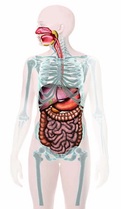
The digestive system turns food into energy that it carries to the cells, packs unused nutrients and excess matter for removal from the body and intakes water to aid in hydration. The digestive system is like an assembly line. It begins with the mouth where the process of digestion begins. The food is sent through the line, from organ to organ, where it undergoes a myriad of processes. It is through theses processes that food, or nourishment, is turned into a substance that the body can utilize for nutrients. Once the body has exponged all of the nutrients it can from the food, the waste is compacted and discarded.
Breaking it down: Level 1: Major Organs: functions + enzymes
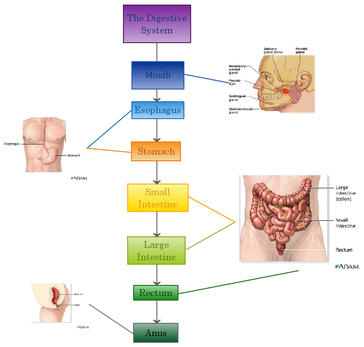
The mouth is where digestion begins. The teeth mechanically digest food by masticating. Salivary glands are located in the mouth and throat. The major ones are the parotid, submandibular and sublingual salivary glands. There are hundreds of glands called minor salivary glands located in the lips, inner cheek and lining of the mouth and throat. All of these glands secrete saliva into the mouth. Saliva moistens the mouth, initiates chemical digestion and helps prevent tooth decay (by breaking down food caught in between teeth). Saliva has lingual lipase thst breaks down carbohydrate and lipid molecules. Amylase in saliva initiates carbohydrate diestion in the mouth.
The esophagus is a muscular tube that attaches to the pharynx and lies between the trachea and the spine. It joins with the stomach. Food is pushed down the esophagus via peristalsis (smooth muscle contractions).
The stomach, iconic organ of the digestive system, is a sort of hollow sack that fills with food that has been pushed into it by the esophagus. It takes the bolus and churns it into chyme. It then breaks down food with enzymes and digestive juices into a form the body can use to nourish cells. Pepsinogen is a gastric enzyme made by the gastric cheif cells in thr stomach that is called pepsin when activated. Pepsin breaks down the protein molecules in food into amino acids and peptide fragments. Hydrochloric acid, HCl, is what we call stomach acid destroys any bacteria in the food. Intrinsic factor (IF) is made in the stomach and helps with absorbtion of vitamin B-12. HCl and IF are made by parietal cells. Mucin is secreted by mucous cells in the stomach and protects the lining of the sotach from its own bacteria and virus killing acid. Gastrin is produced by G cells as a response to stomach stretching. Together all theses enzymes work to digest food.
The small intestine is divisible into three segments: the duodenum which breaks down food via enzymes, the jejunum and the ileum which both absorb nutrients into the bloodstream. Secretin is produced by S cells in response to gastric acid. Gatric Inhibitory peptide (GIP) decreases gastric motility while motilin increases motility. Somatostatin is excreted to inhibit secretory mechanisms. All of these are made in the duodenum. It is important to note that the villi, tiny fingurelike projections in the small intestine, play a key part in absorbtion by increasing the surface area of the absorbtional wall.
The large intestine, including the colon, processes food so it is ready and easy to empty the bowels. It moves stool, food detritus and bacteria, via peristolisis. Stool is made by a process where liquid is made into a solid by losing its water and electrolytes. The colon secretes bicarbonate and potassium and houses bacteria.
The rectum is where stool is held until it is defecated.
he anus is the external opening where stool exits the body.
Note: Sphincters are muscles around tubes that open and close and major intersections in the difestive system, They prevent food from entering and exiting places wehre it is not meant to be.
The esophagus is a muscular tube that attaches to the pharynx and lies between the trachea and the spine. It joins with the stomach. Food is pushed down the esophagus via peristalsis (smooth muscle contractions).
The stomach, iconic organ of the digestive system, is a sort of hollow sack that fills with food that has been pushed into it by the esophagus. It takes the bolus and churns it into chyme. It then breaks down food with enzymes and digestive juices into a form the body can use to nourish cells. Pepsinogen is a gastric enzyme made by the gastric cheif cells in thr stomach that is called pepsin when activated. Pepsin breaks down the protein molecules in food into amino acids and peptide fragments. Hydrochloric acid, HCl, is what we call stomach acid destroys any bacteria in the food. Intrinsic factor (IF) is made in the stomach and helps with absorbtion of vitamin B-12. HCl and IF are made by parietal cells. Mucin is secreted by mucous cells in the stomach and protects the lining of the sotach from its own bacteria and virus killing acid. Gastrin is produced by G cells as a response to stomach stretching. Together all theses enzymes work to digest food.
The small intestine is divisible into three segments: the duodenum which breaks down food via enzymes, the jejunum and the ileum which both absorb nutrients into the bloodstream. Secretin is produced by S cells in response to gastric acid. Gatric Inhibitory peptide (GIP) decreases gastric motility while motilin increases motility. Somatostatin is excreted to inhibit secretory mechanisms. All of these are made in the duodenum. It is important to note that the villi, tiny fingurelike projections in the small intestine, play a key part in absorbtion by increasing the surface area of the absorbtional wall.
The large intestine, including the colon, processes food so it is ready and easy to empty the bowels. It moves stool, food detritus and bacteria, via peristolisis. Stool is made by a process where liquid is made into a solid by losing its water and electrolytes. The colon secretes bicarbonate and potassium and houses bacteria.
The rectum is where stool is held until it is defecated.
he anus is the external opening where stool exits the body.
Note: Sphincters are muscles around tubes that open and close and major intersections in the difestive system, They prevent food from entering and exiting places wehre it is not meant to be.
A continuation of level 1: Pancreas, Liver & Gallbladder
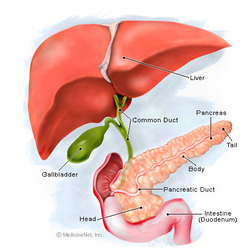
The pancreas is and endocrine and exocrine gland located below the stomach that secretes enzymes (exocrine) and the horomones insulin and glucagon (endocrine). The enzymes are fed into the small intestine. Enzymes it makes include proteases trypsin and chymotrypsin which break down food and chyme even farther. The pranceas makes lipase which preforms hydrolysis. It also makes amylase which hyrdolyses starch into maltose (glucose-glucose disaccharide). It also produces the minor enzymes ribonuclease, deoxyribonuclease, gelatinase and elastase.
The liver absorbs nutirents from the small intestine, breaks down fat and trys to detoxify the body. Two important liver enzymes are Alanine transaminase (ALT) and Aspartate transaminase (AST). ALT processes proteins and AST aids in the metabolism of food (turning it into energy). Bile, an enzyme that aids in the digestion of lipids, is also made in the liver.
The gallblabber stores and secretes bile from the liver into the small intestine that helps break down fats.
The liver absorbs nutirents from the small intestine, breaks down fat and trys to detoxify the body. Two important liver enzymes are Alanine transaminase (ALT) and Aspartate transaminase (AST). ALT processes proteins and AST aids in the metabolism of food (turning it into energy). Bile, an enzyme that aids in the digestion of lipids, is also made in the liver.
The gallblabber stores and secretes bile from the liver into the small intestine that helps break down fats.
Breaking it down: Level 2: Alimentary and Accessory
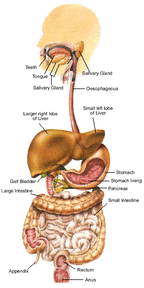
The alimentary part of the digestive system is described as a 27 foot long mucular tube that includes the mouth, pharyx, esophagus, stomach and the small and large intestines. The alimentary has four main layers: mucosa, submucosa, muscularis externa and serosa.
Accessory organs secrete substances (enzymes) into the alimentary tube. Allimentary organs include the pancreas, liver, gallbladder and salivary glands. Theses secretions break down food for absorbiton into tissues.
Accessory organs secrete substances (enzymes) into the alimentary tube. Allimentary organs include the pancreas, liver, gallbladder and salivary glands. Theses secretions break down food for absorbiton into tissues.
Second Helping: Enzymes
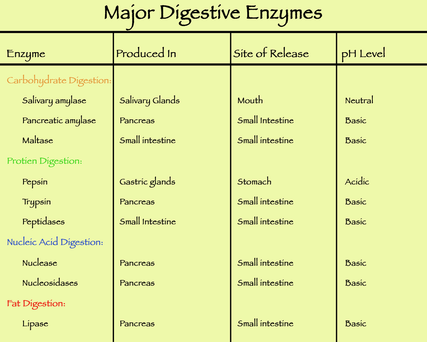
Enzymes are proteins that catalyze chemical reactions. Digestive enzymes break down molecules in food down to their building blocks. Theses building blocks can be then utilized bybody tissues. Digestive enzymes are categorized into proteases, lipases, carbohydrases and nucleases by their target substrate. Proteases split proteins into their monomers; amino acids. Lipases split fats in fatty acids and a glycerol molecule. Carbohydrases split carbohydtrates into starch and sugar. Nucleases split nucleic acids into nucleotides.
Image Citations
http://www.dorlingkindersley-uk.co.uk/nf/ClipArt/Image/0,,239033_1582326_,00.html
http://www.intelligentdental.com/2009/11/25/how-to-prevent-salivary-gland-cancer/
http://www.nlm.nih.gov/medlineplus/ency/imagepages/8756.htm
http://www.nlm.nih.gov/medlineplus/ency/imagepages/8756.htm
http://pennstatehershey.org/healthinfo/surgery/13/100030.htm
http://physiwiki.wetpaint.com/page/Chapter+18
http://commons.wikimedia.org/wiki/File:Major_digestive_enzymes.png
http://www.intelligentdental.com/2009/11/25/how-to-prevent-salivary-gland-cancer/
http://www.nlm.nih.gov/medlineplus/ency/imagepages/8756.htm
http://www.nlm.nih.gov/medlineplus/ency/imagepages/8756.htm
http://pennstatehershey.org/healthinfo/surgery/13/100030.htm
http://physiwiki.wetpaint.com/page/Chapter+18
http://commons.wikimedia.org/wiki/File:Major_digestive_enzymes.png
